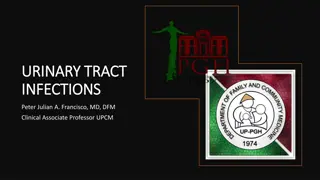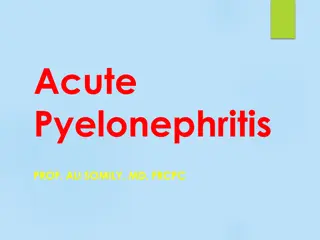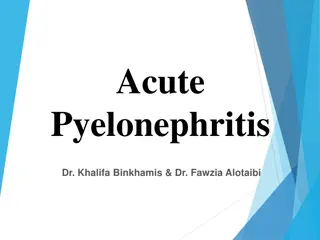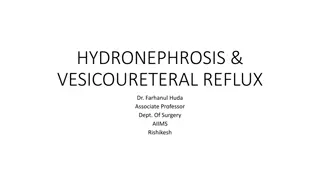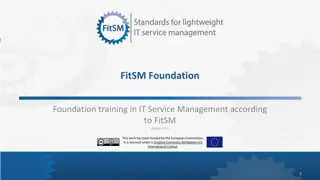Understanding Pyelonephritis: Key Insights and Management
Pyelonephritis is a serious bacterial infection of the kidneys, leading to renal damage and potentially life-threatening complications. This condition has different etiologies, including ascending bacterial infection and hematogenous spread, with Escherichia coli being the most common causative organism. Management involves understanding terminology, clinical presentations, diagnosis, and treatment options, such as antibiotics. It is essential to differentiate between uncomplicated and complicated cases to provide appropriate care and prevent recurrent infections.
Download Presentation

Please find below an Image/Link to download the presentation.
The content on the website is provided AS IS for your information and personal use only. It may not be sold, licensed, or shared on other websites without obtaining consent from the author. Download presentation by click this link. If you encounter any issues during the download, it is possible that the publisher has removed the file from their server.
E N D
Presentation Transcript
Lecture : pyelonephritis important Extra notes Doctors notes " . "
Objectives: Introduction Epidemiology Definition Etiology Pathogenesis Pathology Clinical presentations Diagnosis Treatment and prevention
Only in males slides Introduction: It is very serious condition that lead to renal scarring, nephric, perinephric abscess formation, sepsis Clinical presentation is atypical in some patients Update on the management Pyelonephritis may be acute or chronic UTI Terminology: Uncomplicated: infection of urinary bladder in host w/out underlying renal or neurologic disease Complicated: infection in setting of underlying structural, medical or neurologic disease Recurrent: > 2 symptomatic UTIs within 12 months. following clinical resolution of each previous UTI after therapy Reinfection: recurrent UTI caused by different pathogen at any time or original infecting strain >13 days after therapy of original UTI Relapse: recurrent UTI caused by same species causing original UTI within 2 weeks after therapy
Definition: It is a bacterial of the renal pelvis, tubules and interstitial tissue of one or both kidneys. potentially organ- and/or life-threatening infection that characteristically causes some scarring of the kidney with each infection and may lead to significant damage to the kidney that may lead to hypertension (only in female s slides) Prevalence of bacteriuria in Different age Groups: 30 25 *Women are more prawn to develop bacteriuria due to some factors such as being pregnant, Postmenopausal or an Elderly 20 female male 15 10 5 0 0-3 4 14 15-29 30-64 65-85 >85 Renal pelvis: pyelitis. Bladder: cystitis Urethra: Urethritis. Renal parenchyma: pyelonephritis.
Etiology: Ascending bacterial infection Hematogenous spread Hospital-acquired infections (is rare Except in neonates) 1- Escherichia Coli (most bacterial causes bowel organism eg Ecoli) accounts 70-90% of uncomplicated UTI and 21-54% of Complicated UTI. The uropathogenic E. coli (UPEC) derives from the phylogenetic groups B2 and D, which expresses H,O and K antigens. UPEC genes encode several postulated Virulence factors including adhesives P Fimbraie pap+genotype family , protectins , siderophores and toxins. staph aureus coliforms Enterobacter species mycobacterial tuberculosis (can cause infection every where) Klebsiella pneumoniae / Proteus mirabilis enterococci Staphylococcus saprophyticus (normal flora of vagina) Pseudomonas aeruginosa (hospital acquired) Other etiology Candida (immunecompromised) Brucella (can cause infection every where) Viruses (Adenovirus) Host factor
Risk Factors: Mechanical: Constitutional: Structural abnormalities to the kidneys and the urinary tract such as : (urethral strictures)1 vesicoureteral reflux (VUR) especially in young children urinary tract catheterization (Catheterized patients) nephrostomy2 Pregnancy (half of asymptomatic will develop pyelonephritis if not treated) neurogenic bladder (e.g. due to spinal cord damage, spina bifida or multiple sclerosis) and Obstruction : prostate disease (e.g. benign prostatic hyperplasia) in eldery men bladder tumors calculi (stones) 1: narrowing of the urethra 2: artificial opening created between the kidney and the skin drains urine from your kidney into a collecting bag diabetes mellitus (10 time more admission) immunocompromised states Frequently due to ureterovesical reflux Kidneys enlarged. Interstitial infiltration of inflammatory cells. Abscesses on the capsule and at corticomedullary junction Result in destruction of tubules and the glomeruli. When chronic, kidneys become scarred, contracted and nonfunctioning. Pathology:
Pathogenesis: Only in male s slides Ascending bacterial infection. Hematogenous spread to kidney is rare.Eg; Staph aureus and mycobacterial tuberculosis Exception: neonates with Staph aureus For optimal host defense function, intermittent & complete emptying of bladder must occur. Urine is excellent culture medium Bactericidal secretion from uroepithelial cells and glycoproteins inhibit bacterial adherence Renal parenchyma infections result in inflammatory response to contain infection but contributes to potential scarring. Pathogenesis: Only in female s slides 1. 2. 3. 4. 5. 6. 7. Rectal and/or vaginal reservoirs Colonization of perianal area Bacterial migration to peri-vaginal area Bacteria ascend through urethra to bladder Intercourse may contribute urethral colonization and ascending infection ASB [asymptomatic bacteriuria] in 1st trimester of pregnancy may cause pyelonephritis in 3rd trimester Frequently due to ureterovesical reflux
Symptoms and Signs Chronic Pyelonephritis (causes renal failure) Acute Pyelonephritis Symptoms develop rapidly (<24 hours) and may include: May be unilateral or bilateral. Acutely ill Renal angle tenderness Flank pain or tenderness or both, fever>38 c and chill . Lower urinary tract symptoms: (urgency,dysuria and frequency) Azotemia can occur non infectious causes of these symptoms is Renal infarct and caliculi Confusion in elderly Leukocytosis Pyuria Bacteriuria Nausea and vomiting Unremarkable symptoms: Nausea and general malaise. Systemic signs: Elevated BP, vomiting, diarrhea. Flank pain: pain in the costovertebral angle.
Complications: Hypertension septic shock multi organs failure death. Renal or perinephric abscesses. Metastatic infection. Papillary necrosis. Acute renal failure. Emphysematous pyelonephritis. Renal gangrene. Localized or generalized atrophy/permanent loss of function Differential Diagnosis: 1/5 of the patients. Acute pelvic inflammatory disease. Ectopic pregnancy. Diverticulitis. Renal calculi. Diagnosis : Only in females slides Is not always straightforward A number of studies using immunochemical markers have shown that many women, who initially present with lower tract symptoms, actually have pyelonephritis The extremes of age, the presentation may be so atypicalin the very young (feeding difficulty or fever) In the elderly presentation may be mental status change like confusion or fever
Diagnosis Urine culture In BAP (blood agar plate) and selective media Identify the organism Assess sensitivity and Find the best antimicrobial therapy Bacteria (108/l or 105/ml) in number Confirmed by : Pus > or = 10/HPF (90%), Positive nitrate dipstick test result for RBCs 20-40% in urine and leukocytosis Leukocyte esterase(An enzyme produced by leukocytes) (indicate presence of pus cells) (10 WBC/hpf ) is the usual upper limit of normal Positive result on leukocyte esterase dipstick test correlates well for detecting >10 WBC/hpf, with a specificity of 65% 95%, and sensitivity of 75% 95% Positive nitrate dipstick test result for bacteriuria[ bacteria reduce nitrate to nitrite is only moderately reliable; false-negative results are common urinalysis Blood culture 15-30% To investigate if there is bacteremia / important as this is a systemic infection Ultrasound These indicate Kidneys and urinary tract abnormalities in chronic Pyelonephritis. Also indicates if there are abscesses in the kidney (important because the Antibiotics can not enter the abcess) CT scan IVP (intravenous pyelogram) Identify the presence of obstruction or degenerative changes caused by the infection process BUN and CR Blood urea nitrogen and Creatinine levels of the blood and urine may be used to monitor kidney function Other diagnose approach : Radionucleotide imaging with gallium citrate and indium-111-labeled WBCs IMPORTANT NOTE: the sample for the urinalysis and urine culture should be : (Clean Catch urine sample) extra: What Is a Clean Catch Urine Sample? A clean catch urine sample or specimen is one of the least invasive procedures for a urine culture or urinalysis. The clean catch method aims to prevent bacteria from the skin of the penis or vagina from contaminating the urine specimen. It s important to follow the clean catch process to have accurate results from an uncontaminated sample.
Micturiting cystourethrogram (MCW showing bilateral VUR, grade IV on right and grade III on left- side. There is bilateral ureteral and pelvic dilation with blunting of fornices in the right kidney. Bilateral reflux extending into the pelvicalyceal systems of the kidney without dilatation of the calyces or ureters. (Note catheter in bladder)
Management 1. 2. 3. mild signs and symptoms :Patients may be treated on an outpatient basis with antibiotics for 7-14 days sever cases :Hospitalization Ampicillin with aminoglycoside or third generation cephalosporin, piperacillin or carbapenems in sever cases Empirical treatment is TMP-SMX (trimethoprim-sulfamethoxazole COMBINATION but the Resistance is around 50%) SO fluoroquinolones is alternative . the Empirical treatment is used in the ER when you need to treat the patient quickly (in severe cases) Antibiotics are selected according to results of urinalysis culture and sensitivity and may include broad- spectrum medications 4. 5. Male s slides Treated as outpatients if there is no nausea, vomiting or dehydration and other signs and symptoms of sepsis Very ill patients and all pregnant women are hospitalized at least for 2 to 3 days for parenteral therapy 2 weeks course Bactrim Ciprofloxacin Gentamicin with or without amoxicillin Female s slides
P Prevention: Antimicrobial prophylaxis TMP-SMX or fluoroquinolones 3/week or nitrofurantoin daily Intravaginal estradiol 300 ml of cranberry juice Removal the urinary catheter as soon as possible or use condom catheter P Prognosis: Prognosis is dependent upon early detection and successful treatment Baseline assessment for every patient must include urinary assessment because pyelonephritis may occur as a primary or secondary disorder Only in male s slides Only in male s slides P Problem: Only in female s slides Chronic or recurring symptomless infection persisting for months or years Another 6 weeks course if relapse Follow up urine culture 2 weeks after completion of therapy
Only in females slides Chronic Pyelonephritis: Repeated bouts of acute pyelonephritis may lead to chronic pyelonephritis that may lead to kidney damage and hypertension Clinical manifestations: No symptoms of infection unless an acute exacerbation occurs Fatigue Head ache Poor appetite Polyuria Excessive thirst Weight loss Progressive scarring renal failure Assessment and diagnostic findings: Complications: ESRD=end stage renal disease Hypertension Kidney stones Medical management: According to C&S result Drugs carefully titrated if renal function is impaired IVP Serum creatinine Blood urea Culture and sensitivity
Only in females slides Nursing management Fluid balance I / O chart Fluids encouraged unless contraindicated 4th hourly temp Antibiotics Bed rest Teach how to prevent recurrent infections : adequate fluids, emptying the bladder regularly and performing recommended perineal hygiene taking antibiotics as prescribed
Only in females slides Treatment of Acute Uncomplicated Pyelonephritis Mild or moderate symptoms Hospitalized patients Ambulatory patients IV antibiotic first 48 72 hours followed by 7 days of oral antibiotic therapy 7 14 days of oral therapy with one of the antimicrobials mentioned in the table . Outpatient treatment (total of 7 14 days) oral treatment: Fluoroquinolone TMP/SMX, if uropathogen is known to be susceptible. If Gram-positive pathogen: amoxicillin or amoxicillin-clavulanate Fluoroquinolone IV, then PO Aminoglycoside ampicillin IV, then TMP/SMX PO Third-generation cephalosporin IV, then TMP/SMX PO Eradicate pathogens in kidney and urothelium, and treat/prevent bacteremia
Only in females slides Destruction of approximately 70% of the kidney. Numerous dilated calyces with yellow-brown calculi. The central necrotic areas are surrounded by dense fibrosis. Scarred and contorted kidneys
important Summary (doctor s notes) -Pyelonephritis : usually upper UTI and complicated. - It is acquired usually by 1-Ascending Infection 2- Hematogenous Spread Diagnosis: Bacteria 105CFU/ml , blood culture Symptoms': flank pain , vomiting , fever , diarrhea Local complication : renal abscess , scarring, ischemia Distal complications : bacteria will spread to other organs Risk factors : obstruction , catheterized patients , diabetic, pregnancy (could lead to abortion) Most common organisms : E.coli , staph saprophyticus , klebsiella , proteus mirabilis , enterococci, staphylococcus aureus , pseudomonas aeruginosa , Enterobacter. Prophylaxis : Nitrofurantoin , TMP- SMX , Fluoroquinolones. Treatment: Ampicillin, Aminoglycosides , 3rd generations cephalosporin's , piperacillin , carbapenems. anti-pseudomonas: aminoglycosides , ciproflaxcin , carbapenam, pipracillin. Anti-entrococcus : vancomysin , nitrofurantoin Anti- E-coli : Ampicillin , gentamycin , nitrofurantoin , TMS , Ciproflaxcin, (cepha 2nd , 3rd)
Risk Factors: Etiology and Pathophysiology: most bacterial causes Escherichia coli Hospital-acquired infections may be due to coliforms and enterococci. Haematogenous spread is rare eg Staph aureusand mycobacterial tuberculosis Frequently due to ureterovesical reflux . Pregnancy Diabetes Immunosuppression-Obstruction- Catheterized patients-vesicoureteral reflux-calculi . Summary Treatment: Patients with mild signs and symptoms may be treated on an outpatient basis with antibiotics for 7-14 day Hospitalization in sever cases Empirical treatment is TMP-SMX (Resistance around 50%), fluoroquinolones is alternative Ampicillin with aminoglycoside or third generation cephalosporins, pipracillin or carbapenems in sever case Antibiotics are selected according to results of urinalysis culture and sensitivity and may include broad-spectrum medications. Pathogenesis: Rectal and/or vaginal reservoirs Colonization of perianal area Bacterial migration to perivaginal area Bacteria ascend through urethra to bladder Intercourse may contribute urethral colonization and ascending infection ASB[asymtomatic bacteruria] in 1st trimester of pregnancy may cause pyelonephritis in 3rd trimester Clinical Manifestations of acute pyelonephritis: Diagnosis: Blood culture-BUN and Creatinine levels- Ultrasound or CT scan Complications: ESRD=end stage renal disease- Hypertension -Kidney stones Chills-Fever -Flank pain
SAQ: A 70 year old female visits your clinic , she has fever , flank pain and azotemia and after some test you find her kidneys are enlarged with Abscess formation and there is destruction of Tubules . you diagnose her of having Pyelonephritis . Answer the following based on the information: 1-Based on the information what is the most likely common organism that have infected her ? ANS: E.coli 2- What is the treatment needed? ANS: Ampicillin , Nitrofurontoin TMS, Ciproflaxcin and other 3-what antibiotics could you use to prevent a relapse (prophylaxis)? ANS: Nitrofurantoin , TMP- SMX , Fluoroquinolones 4- in general how do you confirm diagnosis of Pyelonephritis ANS: Blood culture , 105CFU/ml 5- what complications could occur duo to Pyelonephritis? ANS: multi organ failure , septic shock , metastatic infection , papillary necrosis , Acute renal failure , renal gangrene , ,atrophy , emphysematous pyelonephritis.
MCQ: 1-For ambulatory patients we use antibiotics for: A- (3-4wks) B- (7-14wks) C- (7-14days) 6- Which of the following is the organism most likely to be grown and isolated in pyelonephritis? a)Escherichia coli b)Staphylococcus saprophyticus 2- x-ray is used for pyelonephritis diagnosis A- T B-F c)Proteus organisms d)Klebsiella organisms 3- Ascending bacterial infection include: A- candida B- E-coli C- coliforms 7- pyelonephritis It is Bacterial infection of the following except: A) vaginitis. B) cystitis. 4- Hyperlipidemia is a risk factor to pyelonephritis A- T B-F C) pyelitis D) urethritis. 5- A patient is said to have pyuria when pus cells are greater than 10cmm A-T B-F 8- If patient Resist TMP-SMX we use: A)Penicillin B) fluoroquinolones c) macrolides 1-C 2-B 3-B 4-B 5-A 6-A 7-A 8- B
MICROBIOLOGY TEAM: Hamad Alkhudhairy (leader) Talal Alhuqayl Yousef Aljebrin Basel Almeflh Anwar Al souan Majed Alzain Ibraheem Aldeeri Ibrahim Fetyani Abdulmalik Alghanam Nasir Aldosari Shrooq Alsomali (leader) Lama Altamimi Jawaher Alkhayyal Ohoud Abdullah Lama Al-musallam ! We are waiting for your feedback @microbio436 436microbiologyteam@gmail.com The Editing File











